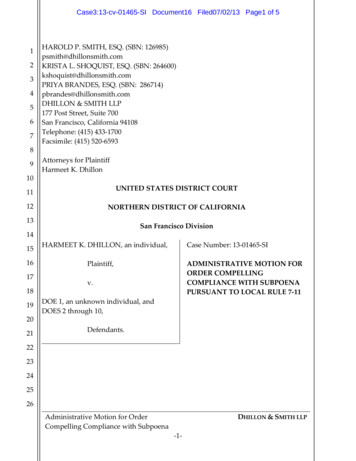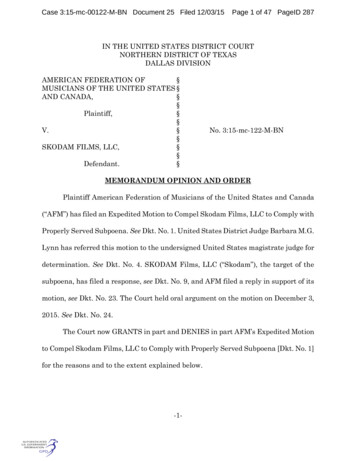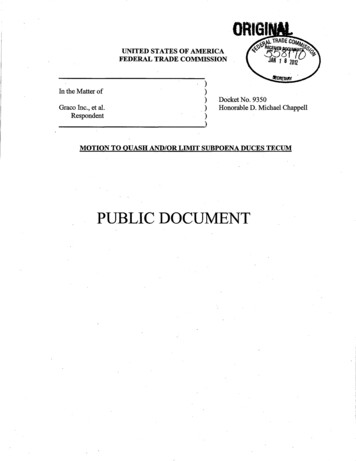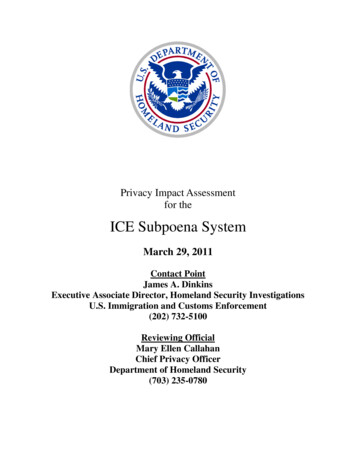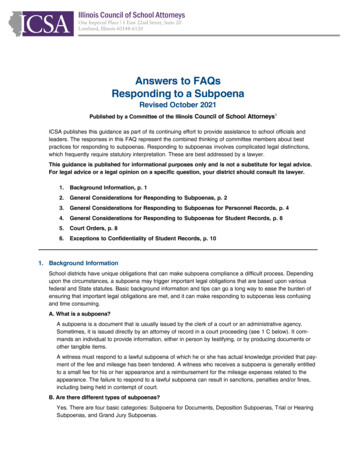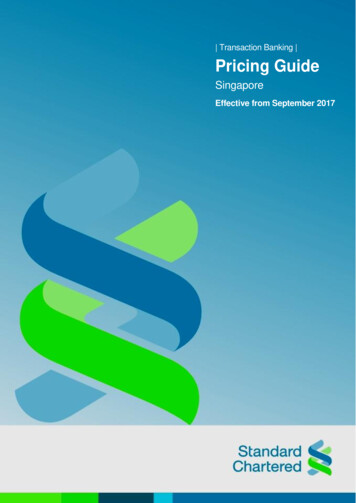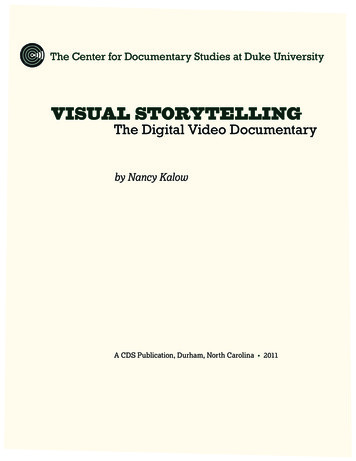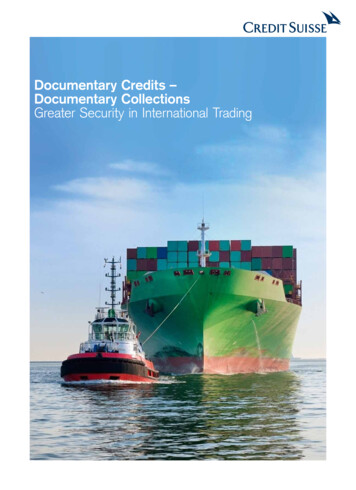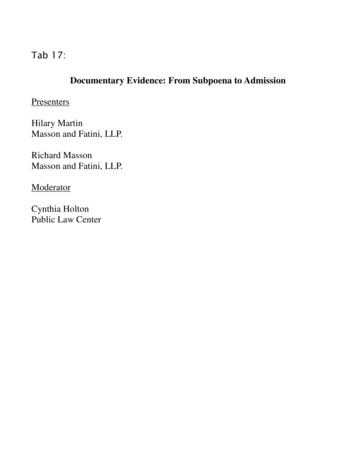
Transcription
Tab 17:Documentary Evidence: From Subpoena to AdmissionPresentersHilary MartinMasson and Fatini, LLP.Richard MassonMasson and Fatini, LLP.ModeratorCynthia HoltonPublic Law Center
Documentary Evidence:From Subpoena toAdmissionPresenters: Richard Masson, Esq. and HilaryMartin with Masson & Fatini, LLPModerator: Cynthia Holton with the PublicLaw Center
SERVING NON-PARTYDEPONENT or BUSINESSRECORDS CUSTODIAN
Who? Where the witness whose deposition is soughtis not a party (or a “party-affiliated” witness),a subpoena must be served to compelattendance, testimony, or production ofdocuments. CCP §§ 2020.010(a)(1),2025.280(b) (CCP § 1985 et seq. dealing withsubpoenas generally also apply to depositionsubpoenas except as modified by § 2020.010et seq.; see CCP § 2020.030.)
Why?–Personal Service of a deposition subpoenarequires a person who is a resident of Californiato appear, testify and produce whateverdocuments or things are specified in thesubpoena; and also to appear in anyproceedings to enforce discovery. CCP §2020.220(c)(3).
How? Use the Mandatory Judicial Council FormsThe original subpoena and proof of serviceare retained by the subpoenaing party. Theyare not filed with the court unless relevant toa motion to compel. CRC 3.250(a)(1)
Three Types of DepositionSubpoenas for Non-PartiesDeponents1. Testimony Only SubpoenaA deposition subpoena may command only the attendance andtestimony of the deponent.2. Records Only SubpoenaA deposition subpoena may command only the production ofbusiness records for copying.3. Records & Testimony SubpoenaA deposition subpoena may command both the production ofrecords (any records) or other physical evidence and testimony(“records and testimony” subpoena) (CCP § 2020.020(a)-(c).)
Deposition Subpoena vs.Document Production Demands to a Party A “business records” subpoena is designed for discovery fromnonparties CCP § 2020.020(b).Opposing party's records can be obtained by a CCP § 2031.010inspection demand. . . . it is easier to obtain discovery from a nonparty using a“business records” subpoena than to obtain discovery from an opposingparty under CCP § 2031.010.This is because: The “business records” subpoena requires production more quickly(e.g., 15 days after service, as opposed to 30 days for § 2031.010et seq. inspection demands). If the opposing party refuses to comply with a § 2031.010 et seq.inspection demand, the burden is on the demanding party to file amotion to compel and show “good cause” for production. No suchshowing is required to enforce a “business records” subpoena.Moreover, the burden is usually on the person seeking to preventdisclosure to show grounds to quash or for a protective order.
Duties of The Custodian of Records Where custodian directed to mail copies toprofessional photocopier: If item “1.a.” on the “business records” subpoenaform is checked, the custodian must mail to thedeposition officer (professional photocopier): A “true, legible and durable copy” of the businessrecords; and affidavit authenticating the copies and therecords (Ev.C. §1561.)Documents must be mailed in a sealed envelope, withthe records enclosed in an inner envelope marked withthe name and number of the lawsuit, the custodian'sname, and the date of subpoena written thereon (Ev.C.§1560(c); CCP §2020.430(b).)
Where custodian directed to deliver copies toprofessional photocopier at custodian'saddress: If item “1.b.” on the “business records” subpoenaform is checked, the custodian may either: Allow the deposition officer to photocopy the records atthe custodian's office; orAllow the deposition officer to pick up at the custodian'soffice photocopies prepared by the custodian uponpaying for the reasonable costs thereof. (Ev.C. § 1563;CCP § 2020.430(c).)The custodian must also furnish an affidavitauthenticating the records. (Ev.C. § 1561; CCP §2020.430(a)(2).)
Where attorney assumes responsibility forinspection and copying: Alternatively, the subpoenaing attorney may direct thecustodian to make the records available for inspection andcopying by the attorney or the attorney's representative atthe custodian's business address during normal businesshours. (Ev.C. § 1560(e); CCP § 2020.430(c)(1).) If given at least 5 days' prior notice, the custodian mustdesignate a time period of at least 6 hours on a date certain forthis purpose.Where this method is utilized, two separate affidavits(declarations) must be obtained: Custodian's affidavit & Attorney’s affidavitAttorney should prepare and provide a template for thecustodian to use in order to ensure that it meets therequirements of Evidence Code §§ 1560, 1561.
Copies of nonparty business records produced inresponse to a subpoena duces tecum areadmissible if accompanied by an affidavit(declaration) by the custodian or other qualifiedwitness. The affidavit (declaration) must: Identify the records; Describe the mode of preparation of therecords; and State that the copies are “true copies” oforiginals prepared in the ordinary course ofbusiness at or near the time of the event.The custodian's affidavit (declaration) ispresumed true and the burden on opposing partyto introduce contrary evidence. (Ev.C. §§ 1560–1562.)
Admissible at Trial? If the foregoing requirements are met, thencopies of business records are admissible at trialin lieu of the originals; and the custodian's (orattorney’s) affidavit may authenticate both therecords and the copies. (CCP § 2020.430(f);Ev.C. §§ 1561, 1562; see People v. Blagg (1968)267 Cal.App.2d 598, 609–610 (Whether copiesor originals, the records involved must qualify as“business records” under Ev.C. § 1271 to beadmissible evidence.)
Civil SubpoenaDuces Tecum for Trial Judicial Council Form Civil Subpoena (Duces Tecum) for PersonalAppearance and Production of Documents andThings at Trial or Hearing and Declaration
How? Prepare Civil Subpoena (Duces Tecum) andNotice of Consumer of RecordsServe Civil Subpoena (Duces Tecum) andNotice of Consumer of Records onParty/Witness.Forward and/or Pay witness fees todeponent/non-party witness.Personally serve Subpoena on non-partywitness with BOTH Notice of Consumer andCivil Subpoena (Duces Tecum).
SERVING THE DEPOSITION SUBPOENA How? Serve the deposition subpoena via Personal ServiceWhy? Personal service obligates any resident of California toappear, testify and produce whatever documents orthings are specified in the subpoena; and to appear inany proceedings to enforce discovery. CCP §2020.220(c)
How to Enforce?1. Motion to compel compliance If a nonparty disobeys a deposition subpoena, thesubpoenaing party may seek a court order compelling thenonparty to comply with the subpoena within 60 days aftercompletion of the deposition record. (CCP §§ 1987.1,2025.480(b))A nonparty opposing such motion without substantialjustification is subject to sanctions. (CCP §§ 1987.2(a),2020.030, 2025.480)The objections or other responses to a business recordssubpoena are the “deposition record” for purposes ofmeasuring the sixty (60) day period for a motion to compel.(Unzipped Apparel, LLC v. Bader (2007) 156 Cal.App.4th123,132–133.)
2. Contempt proceedings A deponent who disobeys a deposition subpoenamay be punished for contempt, without thenecessity of a prior court order directingcompliance by the witness or any showing of goodcause. (CCP §§ 1209(a)(9), 1991.1, 2020.240,2023.030(e)) Consider contempt proceedings only if the witnessdisobeys a specific court order or otherwise ispersistently recalcitrant.
3. Civil damages action by the aggrievedparty The subpoenaing party can also file a civil actionagainst the witness who disobeys the subpoena torecover a forfeiture of 500, plus all damagessustained as a result of the witness' failure toattend (e.g., attorney fees and depositionexpenses). (CCP §§ 2020.240, 1992) “The simple economics of modern litigation essentiallypreclude such an action.” New York Times v. Sup.Ct.(Sortomme) (1990) 51 Cal.3d 453, 464.
CHALLENGING THEDEPOSITION SUBPOENAWHO? Any of the three parties involved maychallenge the subpoenaNonparty Witness Who Was Subpoenaed Plaintiff / Petitioner Defendant / Respondent
WHY?A Deposition Subpoena may be attackedon the following grounds:a. Defects in Form or Content of Subpoena: These failures can include inadequate description ofrequested documents in “records only” or “records andtestimony” subpoenas.b. Defects in Service of the Subpoena: These failures can include, failure to properly identifyperson, failure to properly tender fees; failure to properlyserve named party; and
c. Defects with Documents Requested: These failures can include requests for documents thatare not within permissible scope of discovery.For example, the requested documents are subject toobjections that: the documents are “privileged”; “subject to privacy protections”; or constitute “attorney work product”; or simply not “relevant to the subject matter”.In addition, the requests are simply unjustly burdensomeor oppressive demands.In addition, the requests invoke the privacy concerns,(e.g., “Consumer's” right of privacy in “personal records”or “Employee’s right of privacy in “employment records”(CCP §§ 1985.3(e), 1985.6.)
HOW TO OPPOSE?1. Procedure: Motion to Quash Who Must File It? A party to the action must file a motion to quash to stayproduction of the subpoenaed documents (CCP §1985.3(g).)When Do You File It? The Motion to Quash must be served on the witness anddeposition officer five (5) days before the date set forproduction of the subpoenaed records (CCP §§1985.3(g), 1985.6(f).)Failure to meet this deadline does not invalidate themotion but excuses the officer from liability for improperrelease of the subpoenaed records
What Is Required For Motion to Quash?1. Points & Authorities2. Declaration of Good Faith Meet & Confer3. Separate Statement A motion to quash production of documents at adeposition must be accompanied by a separatestatement setting forth the particular documents ordemands at issue and the factual and legal reasonswhy production should not be compelled. (CRC3.1345(a)(5).)
Sanctions? Discretionary Against Losing Party If the Court finds that the Motion was “made or opposed in badfaith or without substantial justification, or that one or more ofthe requirements of the subpoena was oppressive,” then theCourt may order the losing party to pay the prevailing party'sexpenses, including reasonable attorney fees, incurred on themotion to quash. (CCP § 1987.2(a).) Mandatory In Certain Situations Notably, the court must make such an award where thesubpoena was served on an Internet Service Provider (ISP) for“personally identifying information” if :The information is sought for use in litigation outside Californiainvolving the moving party's exercise of free speech rights(e.g., a defamation action based on anonymous Internetpostings); andThe motion is granted because the respondent fails to make aprima facie showing of a valid cause of action. (CCP §1987.2(b).)
Pending Outcome of Motion to QuashProduction Is Automatically Stayed(CCP §§ 1985.3(g), 1985.6(f)(3).)
2. Procedure: Written ObjectionsWho? Nonparty “Consumer” (CCP §1985.3)“Employee” (CCP §1985.6)One who is not a party to the action is not required tofile a motion to quash. (CCP § 1987.1(c).)What? Written ObjectionsServe subpoenaing party, the records custodian andthe deposition officer with written objections toproduction of the subpoenaed records, statingspecific grounds on which production of the recordsshould be prohibited (e.g., invasion of privacy). (CCP§§ 1985.3(g), 1985.6(f)(2).)
Pending Resolution of the WrittenObjections Production Is AutomaticallyStayedService of written objections by a nonparty “consumer”or “employee” automatically excuses the custodian anddeposition officer from producing the subpoenaedrecords until the court orders their production or theparties stipulate thereto. (CCP §§ 1985.3(g),1985.6(f)(3).)
Getting Around Written Objections Who? Burden of obtaining a court order for the documentsis on the party seeking the discovery. (CCP §§1985.3(g), 1985.6(f)(4)).
What?Procedure: Motion to enforce subpoena overwritten objections. (CCP §§ 1985.3(g), 1985.6(f)(4)).1. Points & Authorities2. Separate statement (CRC 3.1345(a)(5)).3. Attempt to resolve informally Declaration showing a “reasonable and good faith attempt atinformal resolution of the dispute” between the partyrequesting the records and the “consumer” or “employee”whose records are involved or counsel for such person. (CCP§§ 1985.3 (g), 1985.6(f)(4)).4. Serve Motion on all interested parties Although not specifically required by statute, on the“consumer” or “employee” if not a party to the action.
When? Within twenty (20) days after service of thewritten objections. (CCP §§ 1985.3(g),1985.6(f)(4)).
Enforcing The “WrittenObjections” Who? Any party or witnessHow? Protective Order against the subpoena ordeposition proceedings. The court may make whatever orders areappropriate to protect any party, witness or“consumer” from “unreasonable or oppressivedemands, including unreasonable violations of awitness‘ or consumer's right of privacy.” (CCP §1987.1; see CCP § 2025.420(b))
Admissibility of SubpoenaedDocuments Why Is Admissibility In Question?Hearsay Hearsay is an out of court statement made for thetruth of the matter asserted. (Evid.C. §1500).
Exception Business Records Exception to the HearsayRule Business records constitute hearsay, but are admissible as an“exception” under the “Business Records” exception inCalifornia if there is a preliminary showing that the record issufficiently reliable and only for two distinct hearsaypurposes:1. To prove the occurrence or existence of an act,condition or event recorded in the record (Ev.C.§1271).However, where a record is offered to prove an event or conditionoccurred or existed, it must appear that the sources of informationand method and time of record preparation “were such as toindicate its trustworthiness.” (Ev.C. §1271(d)).
OR2. Where a record is offered to prove thenonoccurrence or nonexistence of an act,condition or event not recorded in therecord. (Ev.C. §1272).However, where the absence of a business record entry isoffered to prove an event or condition did not occur or exist,it must appear that the sources of information and methodand time of record preparation “were such that the absenceof a record” of the matter in question “is a trustworthyindication” the matter did not occur or exist.” (Ev.C.§1272(b)).
Business Record Exception to the HearsayRule, Foundational Requirements to ProveEvent Occurred A business record is admissible to prove theoccurrence or existence of the act, condition or eventrecorded if all of the following foundationalrequirements are met: The writing must have been made in the “regularcourse of business”The writing must have been made at or near the time ofthe act, condition or event recorded;The record's custodian “or other qualified witness”must testify to its identity and mode of preparation;andThe sources of information on which the record is basedand method and time of the record's preparation “mustbe such as to indicate its trustworthiness”. (Ev.C. §1271).
These are preliminary fact determinations and aresubject to the trial court's broad discretion. “In determining whether a writing meets therequirements of [Evidence Code §1271] the trial judge isvested with broad discretion the exercise of which,absent a showing of abuse, will not be disturbed onappeal.” Exclusive Florists, Inc. v. Kahn (1971) 17Cal.App.3d 711, 716; see also Aguimatang v. CaliforniaState Lottery (1991) 234 Cal.App.3d 769, 797.
The Business Records exception to the HearsayRule essentially requires that the subpoenaeddocuments were: Prepared in the “regular course of business”Prepared in the ordinary course of the business activityinvolvedThat it was the business’ regular practice to make theparticular recordThat the entry was based upon the firsthand observation ofsomeone whose job it is to know the facts recorded. Where it appears that the record was NOT based on therecorder’s personal knowledge or that of someone with abusiness duty to observe and report the matters recorded isinherently unreliable for its truth and thus, inadmissible assubstantive evidence of the matter so recorded. (Ev.C. § 1271;Zanone v. City of Whittier (2008) 162 Cal.App.4th 174, 191).
The Business Records ExceptionLimitation: Must be a Business Record of “act, condition orevent” – not mere conclusionA writing prepared as a part of a normalbusiness activity is admissible under the“business records exception” only if it records(and is offered to prove) an act, condition orevent (or the absence thereof) in the ordinarycourse of business. Writings reporting onlyconclusions are not made admissible byEvidence Code §§ 1271 and 1272 simplybecause they appear in a business record.(People v. Reyes (1974) 12 C3d 486, 503, 116CR 217, 227; Taggart v. Super Seer Corp.(1995) 33 CA4th 1697, 1708, 40 CR2d 56, 63).
Requirements to Prove Event DIDNOT Occur Evidence of the absence from a business recordof a particular act, condition or event isadmissible notwithstanding the hearsay rule toprove the nonoccurrence of the act or event orthe nonexistence of the condition.
A business record is admissible to prove theoccurrence or existence of the act, condition orevent recorded if all of the followingfoundational requirements are met:1. Matter would have been recorded in“regular course of business” The proponent must demonstrate it was the regularcourse of the particular business to make records of thetype of acts, conditions or events in issue at or near thetime of the act, condition or event (Ev.C. § 1271).In other words, it must appear the particular entrywould have been made, had the act, condition or eventoccurred, in the routine course of the organization'sprimary business activities
2. Regular business practice to preserverecords: The proponent must also demonstrate it was theorganization's regular business practice to preserverecords of the type in question. (Ev.C. § 1272(a)).In other words, if the business did not make it a habit topreserve records of acts, conditions or events of the typein question, the absence of such a record is simply notreliable proof that the act, condition or event did notoccur or did not exist.3. Trustworthiness It must appear that the sources of information andmethod and time of preparation of the business' records“were such that the absence of a record of an act,condition, or event is a trustworthy indication that theact or event did not occur or the condition did not exist.”(Ev.C. § 1272(b)).The trustworthiness decision lies within the trial court'sbroad discretion.
Rationale: The failure of a regularly-kept and properlyauthenticated record to mention a matter thatwould ordinarily be mentioned in the normalcourse of business is deemed sufficientlyreliable proof of its nonexistence.Stated another way, if the record is deemedsufficiently reliable to prove an affirmativematter, logically it should be just as reliable toprove a negative fact. See People v. Torres(1962) 201 Cal.App.2d 290, 297.
Exception: Past Recollection RecordedIn some situations, writings admissible under §1271 might also be admissible under the “pastrecollection recorded” hearsay exception.(Ev.C. § 1237).This exception, however, rest on an entirelydistinct foundational requirements from theBusiness Records exception – Evidence Code §1237 encompasses any writing made by thedeclarant.
Declarant's present recollection: A writing is admissible as substantive proofas “past recollection recorded” only if thedeclarant's memory is so impaired that he orshe cannot testify accurately to the recordedevents from present recollection. NOTE: Business records are admissible underEvidence Code §1271 regardless of whether thedeclarant can now testify fully and accurately tothe recorded events.As such, one of the primary objectives of § 1271 isto eliminate the necessity of calling as witnesseseach employee who prepares business reports.(People v. Williams (1973) 36 Cal.App.3d 262,275; see Levy-Zentner Co. v. Southern Pac.Transp. Co. (1977) 74 Cal.App.3d 762, 785.)
Multiple Hearsay Problems Even when a writing is prepared in the normalcourse of business and qualifies as a businessrecord under Evidence Code §1271, it mayencounter “multiple hearsay” problemsbecause such records often containextrajudicial statements made by others. Each layer of multiple hearsay must beanalyzed separately. (See People v. Ayers(2005) 125 CalApp.4th 988, 994–996; Zanonev. City of Whittier (2008) 162 Cal.App.4th 174,192; Alvarez v. Jacmar Pac. Pizza Corp. (2002)100 Cal.App.4th 1190, 1205, 122).
Introduction of Business Records at Trial orHearing -- How?Introduce properly authenticated businessrecord. Introduction of the record itself (provided it is sufficientlyauthenticated to satisfy the trustworthiness requirement); Qualified Witness Testimony Testimony from the business records custodian “or otherqualified witness” (employee who can vouch for theaccuracy of the recordkeeping process), when the recordsare so voluminous as to make it “impossible or impracticalto produce them” Qualified Witness Affidavit Affidavit from the records custodian “or other qualifiedwitness” (Ev.C. §§1560, 1561.) NOTE: Proof by affidavit is not permissible in criminalproceedings, as it would violate the defendant's SixthAmendment right of confrontation. (People v. Dickinson(1976) 59 Cal.App.3d 314, 318–320.)
QUESTIONS .
1. Motion to compel compliance If a nonparty disobeys a deposition subpoena, the subpoenaing party may seek a court order compelling the nonparty to comply with the subpoena within 60 days after completion of the deposition record. (CCP §§1987.1, 2025.480(b)) A nonparty opposing such motion without substantial justification is subject to .
